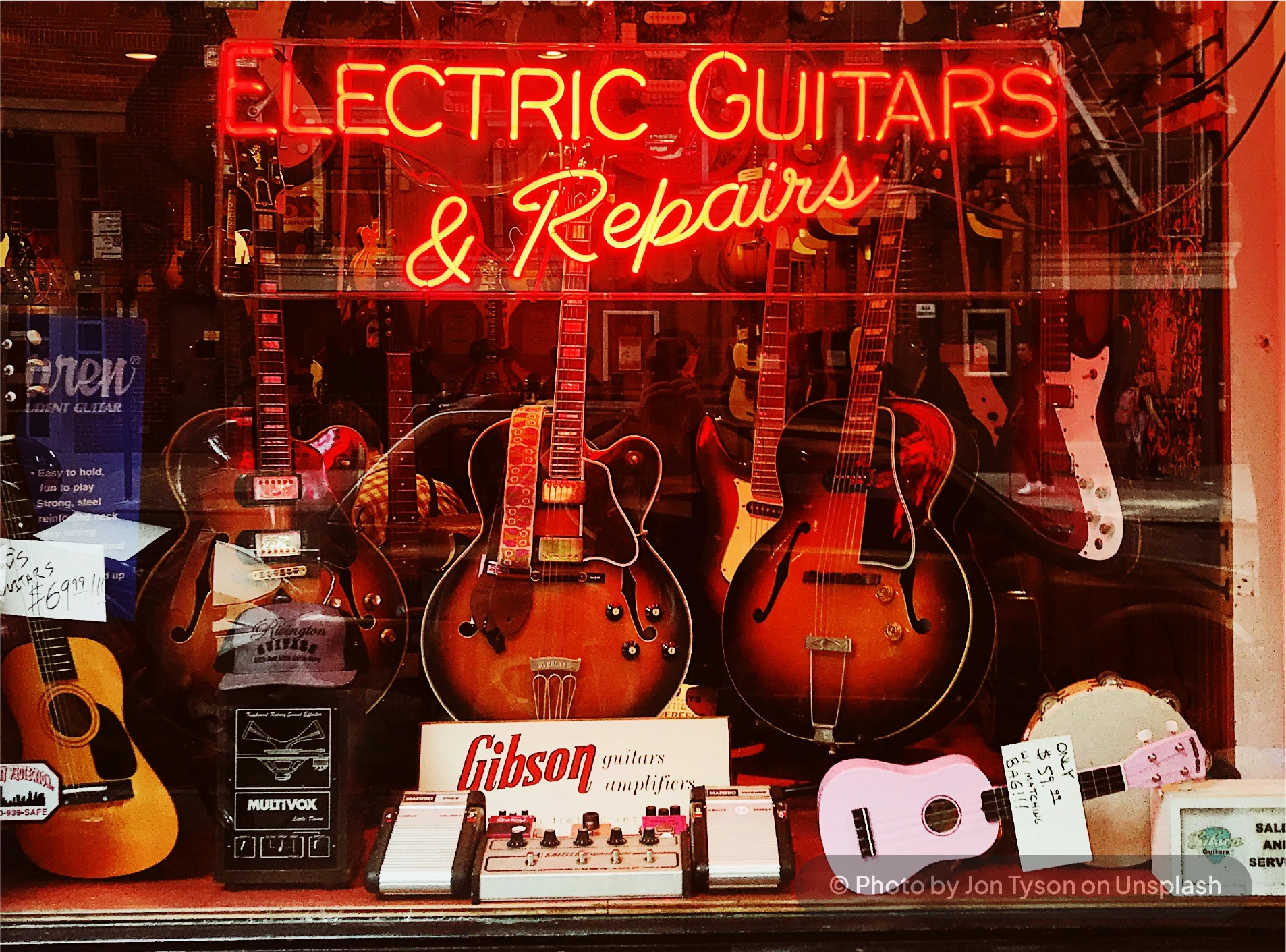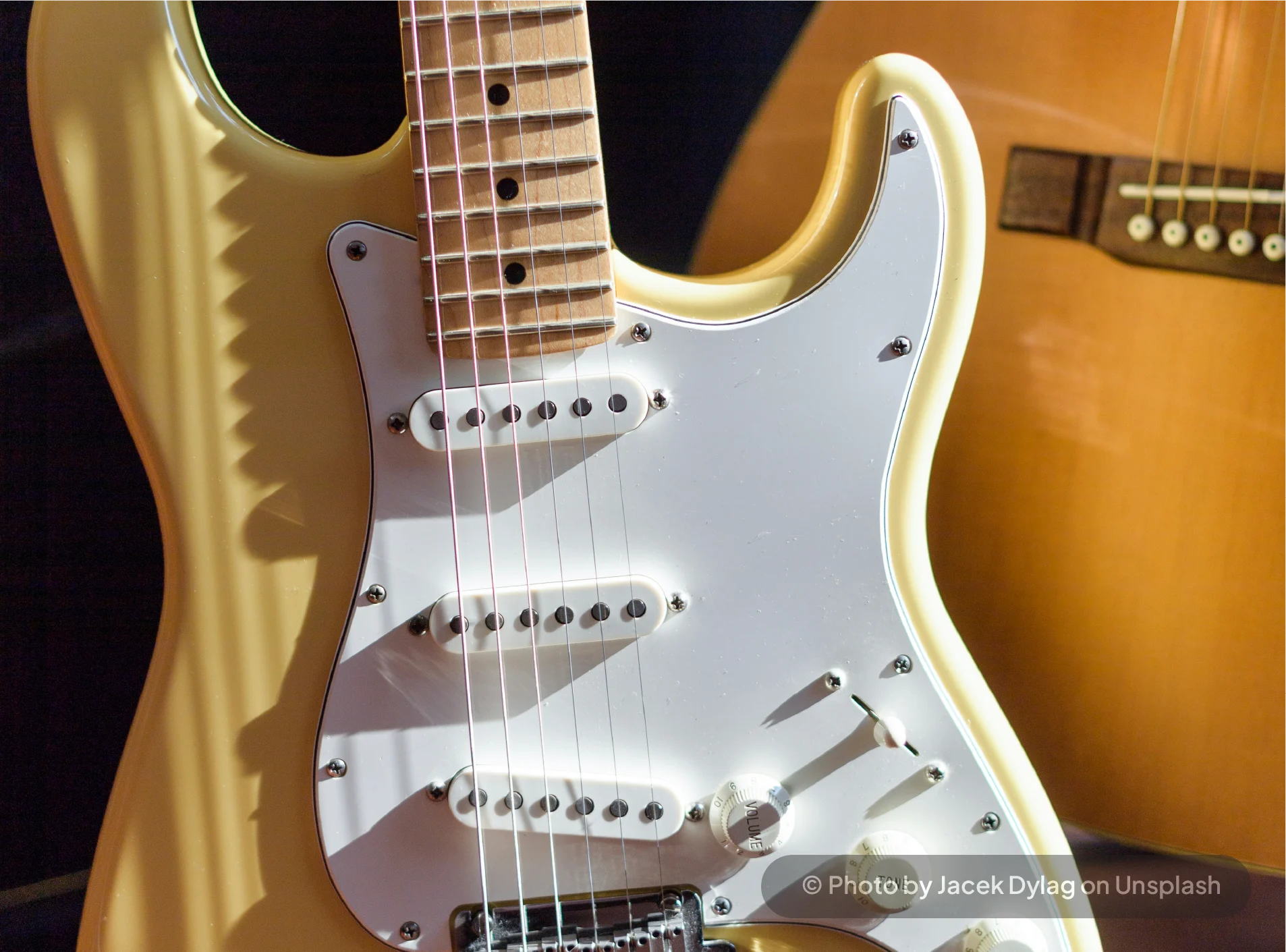Electric Guitar: How it Works, Types & Buying Guide
The electric guitar is more than just a musical instrument—it’s a symbol of modern music that has left its mark on genres ranging from rock and blues to jazz, pop, and metal. In this article, we’ll explore the electric guitar’s journey, from its invention to its widespread influence today. You’ll learn about the electric guitar's essential parts, how it works, different playing styles, and practical tips for beginners looking to buy their first guitar. Whether you're just getting started or looking to deepen your understanding, this guide is designed to inspire and inform.
So without further ado, let’s get started…
What is an Electric Guitar?
An electric guitar is a stringed musical instrument that utilizes electromagnetic pickups to convert the vibration of its strings into electrical signals. These signals are then amplified and processed to produce sound, making the electric guitar louder and more versatile than its acoustic counterpart.

Over the decades, music legends have used the electric guitar as an ally to turn ordinary stages into unforgettable experiences and have reshaped the very soul of modern music. Jimi Hendrix’s fiery solos, Eric Clapton bluesy bends, Jimmy Page’s, Carlos Santana blend of Latin rhythms with electric soul… and the greatest guitarists of all time. And all these validate the essence of an electric guitar over and over again. It isn’t just an instrument—it’s a storyteller, a revolution, and a deeply personal form of expression.
The electric guitar is more than an instrument—it’s a voice for emotions that words often fail to express. With just six strings and a curious blend of wood, metal, and electronics, it holds the power to whisper a lullaby or roar like a storm.
Its sound doesn’t come from its body alone, but from an invisible current that runs through wires and pickups, brought to life through amplifiers. There’s something mysterious in how this instrument transforms simple vibrations into music that can move hearts, ignite rebellions, or echo the longing of a quiet soul. Whether played in a dimly lit bedroom or on a roaring concert stage, the electric guitar remains a symbol of freedom, creativity, and raw, electric emotion.
A Brief History of the Electric Guitar
The invention of the Electric Guitar in the early 20th century revolutionized how music was played, performed, and heard.
Early Beginnings (1920s–1930s)
Before electricity entered the scene, guitarists struggled to be heard in big bands and orchestras, where horns and percussion dominated. To solve this, inventors began experimenting with ways to amplify the guitar’s sound. By the late 1920s, magnetic pickups were developed—devices that converted string vibrations into electrical signals.
The first commercially successful electric guitar was the Rickenbacker “Frying Pan” (1931), a lap steel guitar created by George Beauchamp and Adolph Rickenbacker. It paved the way for amplifying guitars without losing their tonal character.
The Solid-Body Revolution (1940s–1950s)
As amplification improved, a new problem arose: hollow-body electric guitars produced unwanted feedback at high volumes. Innovators like Les Paul and Leo Fender solved this by introducing solid-body electric guitars.
- Les Paul’s “Log” (1941): A prototype with a solid block of wood that reduced feedback.
- Fender Telecaster (1950): The first mass-produced solid-body electric guitar.
- Gibson Les Paul (1952): A collaboration between Gibson and Les Paul that became iconic.
These guitars not only eliminated feedback but also produced brighter, more sustained tones—perfect for emerging music styles.
Shaping Modern Music (1960s–1980s)
The electric guitar quickly became a cultural symbol. In the 1960s, players like Jimi Hendrix, Eric Clapton, and George Harrison expanded its possibilities with distortion, feedback, and effects pedals. Rock ‘n’ roll, blues, and psychedelic music flourished with the guitar at the center.
By the 1970s and 1980s, heavy metal and hard rock pushed the instrument to louder, faster, and more aggressive territories. Innovations like humbucker pickups (for a thicker tone), whammy bars, and custom designs gave musicians endless sonic variety. Brands like Fender, Gibson, Ibanez, and Jackson became household names.
The Digital Era (1990s–Present)
With the rise of digital technology, the electric guitar adapted yet again. Modeling amps, effects processors, and even digital guitars now allow musicians to emulate countless tones. Despite electronic music’s rise, the electric guitar remains central to rock, pop, indie, and metal.
Legacy
From smoky jazz clubs to stadium rock concerts, the electric guitar has defined the sound of the 20th century and beyond. More than just an instrument, it represents innovation, rebellion, and creativity—continuing to inspire generations of musicians worldwide.
How Does an Electric Guitar Work?
Behind the sleek body of the electric guitar lies a fascinating process that transforms the movement of strings into powerful sound.:
=> String Vibration
Everything starts the moment you pluck, pick, or strum a string. The string begins to vibrate rapidly, creating energy. These vibrations are at the heart of the sound, but unlike an acoustic guitar, an electric guitar doesn’t rely on a hollow body to amplify this movement. Instead, it turns to technology to carry the sound forward.
=> Pickups: The Heart of the Electric Guitar
Right beneath the strings are components called pickups. These are essentially magnets wrapped tightly with very thin copper wire. The magnets react to the vibration of the strings. Each string hovers just above these pickups, which are carefully placed to capture its motion.
=> From Vibration to Electric Signal
Here’s where science gets magical. The guitar strings are made of metal, and when they vibrate over the pickups, they cause a small change or disturbance—in the pickup’s magnetic field. According to the principles of electromagnetism, this disturbance generates a tiny electrical signal in the wire coil inside the pickup. This signal is a direct reflection of the way the string is vibrating—its pitch, tone, and intensity.
=> Sending the Signal: Cable Connection
The weak electrical signal produced by the pickups is not strong enough to be heard on its own. It needs a boost. So, it travels through a cable connected to the guitar’s output jack and heads straight to an amplifier.
=> Amplification and Speaker Output
The amplifier receives the signal and increases its strength dramatically. Think of it as a translator that makes your guitar’s quiet electrical voice loud enough for the world to hear. After the signal is amplified, it is sent to a speaker, which turns the electrical energy into sound waves that we can hear. This is what you finally hear—a loud, clear sound that can be soft and clean or wild and distorted.
=> Shaping the Sound
Electric guitars offer much more than just volume. Built-in controls like tone knobs and volume knobs help players adjust the sound right from the guitar body. The pickup selector switch allows the player to choose between different pickups—or blend them—to create a variety of tones and sound textures.
To go even further, players often use effects pedals—devices that sit between the guitar and amplifier—to add effects like distortion, delay, reverb, or wah-wah. These tools give the electric guitar its signature versatility, allowing each player to create their own unique sound.
Together, this elegant mix of physics, engineering, and artistry is what gives the electric guitar its iconic voice—powerful, expressive, and endlessly adaptable.
How to Choose Your Electric Guitar?
Buying your first electric guitar—or even upgrading to a better one—can feel overwhelming with so many styles, shapes, and features out there. But if you know what to look for, it becomes an exciting journey toward finding the guitar that truly fits your sound and style.
i) Consider the Music Style
The first thing to consider is the kind of music you want to play. Your choice of guitar should reflect your musical taste. If you're into blues, rock, or country, guitars like Stratocasters or Telecasters are great options. On the other hand, if you're leaning toward heavier rock or metal, a Les Paul or SG might suit you better. Jazz or indie musicians often go for hollow or semi-hollow body guitars that offer a warmer, more resonant tone.
ii) Body Type

Next, think about the body type of the guitar. Solid-body guitars are the most versatile and handle high gain and effects really well. Semi-hollow bodies give you a nice balance between acoustic warmth and electric power, while fully hollow bodies deliver rich, full tones—though they can be prone to feedback at high volumes.
iii) Learn How Different Wood Create Different Sound
The wood used in a guitar—often referred to as tonewood—also influences the sound. Mahogany tends to give a warmer, rounder tone, while alder and ash produce brighter, punchier sounds. Maple adds clarity and brightness, which is great for cutting through a mix.
iv) Pay Attention to the Neck Profile and Scale Length
The shape of the neck affects how comfortable it feels in your hand, with C-shaped necks being a popular choice for beginners. Scale length—basically the distance between the nut and the bridge—affects both tone and playability. Shorter scales, like those on many Gibson guitars, make string bending easier and create a warmer sound. Longer scales, like those on Fender models, produce a brighter tone and more string tension.
v) Pickups
Now let’s talk about pickups, which are a key part of your guitar’s voice. Single-coil pickups are known for their bright, crisp sound—perfect for blues, funk, and classic rock. Humbuckers, by contrast, offer a thicker, warmer tone, and are better suited for heavier styles like hard rock and metal. Some guitars even mix both pickup types to give you more tonal flexibility.
vi) Consider Your Budget
When it comes to budget, it's smart to invest in quality, especially if you're serious about learning or performing. While entry-level guitars can be decent, spending a bit more often means better craftsmanship, longer durability, and a more satisfying playing experience. Starter packs are a great choice for beginners—they usually come with everything you need: the guitar, an amplifier, a cable, strap, and sometimes even a tuner and case.
vii) Don’t Miss The Trial
If you can, always try the guitar before buying. Feel how it sits on your lap or shoulder. Notice how comfortable the neck is in your hand. Play it unplugged and plugged in—both sounds matter. You want a guitar that feels good and sounds right to you.
viii) Top Brands to Choose From
Finally, choose a brand that’s known for consistency and support. Brands like Fender, Gibson, PRS, Ibanez, and Yamaha have been trusted by players for decades. Also check if there’s a warranty or good return policy, just in case something doesn’t feel quite right once you bring it home.
All in all, choosing an electric guitar is about balancing comfort, sound, style, and budget. When you find the right one, it’s not just a purchase—it’s the beginning of a new musical adventure.
What are the Different Types of Electric Guitar?

i) Solid-body electric guitars
They are like the Stratocaster, Telecaster, Les Paul, and SG are the most popular types used across genres, from rock and blues to pop and metal. These guitars are made from a solid slab of wood, which reduces feedback and allows for a wide range of tonal possibilities.
ii) Stratocaster
The Stratocaster is known for its bright, glassy tones and versatility, the Telecaster for its sharp twang and clarity, the Les Paul for its warm, thick sustain, and the SG for its raw, punchy attack—making each suited for different playing styles.
iii) Semi-hollow Guitars
Semi-hollow guitars combine features of both solid and hollow-body designs. They have a solid center block to reduce feedback, with hollow wings that add resonance and warmth. This blend makes them ideal for players seeking a versatile sound that works well for jazz, blues, indie, and even light rock.
iv) Hollow-body Guitars
Hollow-body guitars, with their fully hollow chambers, deliver a deep, resonant, and acoustic-like tone. They are especially favored in jazz, soul, and blues for their warm, smooth sound. However, due to their open design, they can be more prone to feedback at high volumes, making them better suited for lower-gain settings and clean tones.
How Do You Play the Electric Guitar?
To begin, learn the basic parts of your electric guitar—headstock, neck, body, pickups, and controls. Get the essentials: guitar, amp, cable, tuner, and pick. Tune your strings to E–A–D–G–B–E.
Hold the guitar comfortably, pressing the strings just behind the frets. Start with simple open chords like E minor, G, and A, then move to basic strumming and riffs. Explore your amp’s settings to shape your tone and try out power chords for a rock feel.
Practice daily, even for 20 minutes—it builds skill fast. For a deeper dive, check out how to play guitar.
If compared with an acoustic guitar, both share similar core techniques; electric guitars are often considered easier to play due to their lower action, thinner strings, and the ability to use amplifiers and effects.
Final Note - About Electric Guitars
The electric guitar is not just a tool—it’s a lifelong companion for creative expression. From its rich history and intricate mechanics to the countless styles it can support, the electric guitar continues to shape modern music in powerful ways. Whether you're picking up your first guitar or deepening your understanding of how it all works, the journey is as thrilling as the music itself.
So plug in, turn up the volume, and let your fingers tell your story - because with the electric guitar, every note is a step toward finding your unique sound.
If you’re ready to begin or advance your journey, explore online guitar lessons.
Yes, absolutely! Electric guitars are often easier for beginners to start with because they have lighter strings and lower action (the distance between the strings and fretboard), making them gentler on the fingers. Plus, they’re versatile across genres and fun to play with amps and effects.
The most trusted and popular guitar brands in India for quality and value include: Yamaha – Reliable for both beginners and pros, Fender – Known for classic tones and solid build, Cort – Great range with good pricing, Ibanez – Sleek design and fast playability, and Kadence – Affordable and beginner-friendly.
As of now, the "Reach Out to Asia" Fender Stratocaster, signed by legends like Eric Clapton, Jimmy Page, and Brian May, is the most expensive electric guitar ever sold—fetching $2.7 million at auction. Among playable guitars, Eric Clapton’s “Blackie” Strat sold for $959,500.
There’s no single “best” style—it depends on your music taste and playing goals. Solid-body guitars (like Stratocaster, Les Paul) are best for rock, blues, pop, and metal. Semi-hollow is great for jazz, blues, and indie. And Hollow-body is ideal for jazz and clean tones. Choose a style that matches the sound and feel you’re aiming for.














